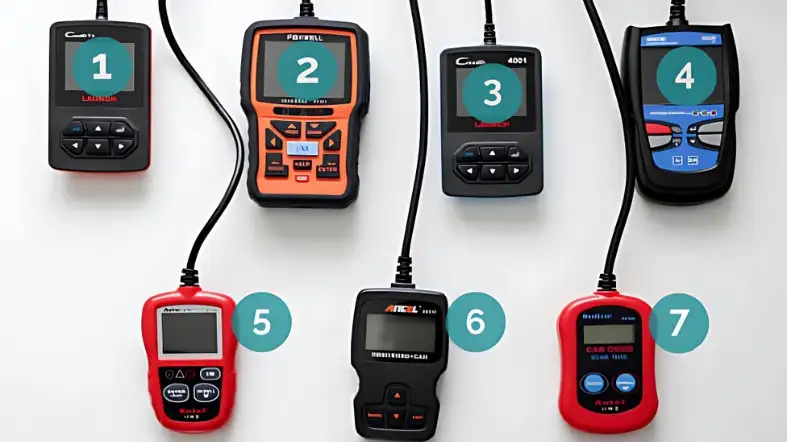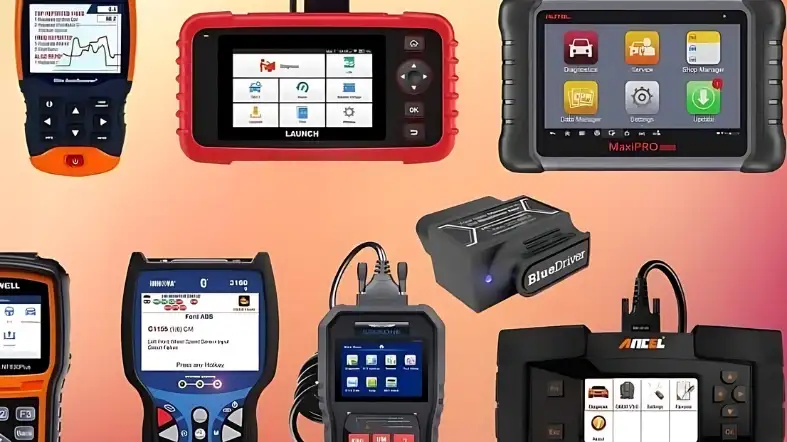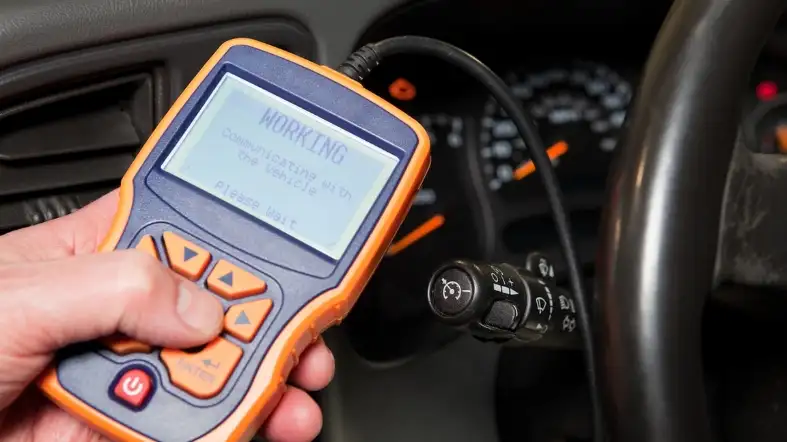Need to check what’s wrong with your car? Wondering where to find OBD2 scanners near you?
Let me be your guide! I’ll show you the best places to buy these handy devices.
From trusted auto parts stores like AutoZone and Advance Auto Parts to online marketplaces like Amazon, we’ll navigate the world of OBD2 scanners together.

Best Places to Find OBD2 Scanners
If you’re looking for OBD2 scanners, here are some of the best places to find them:
1. AutoZone
AutoZone is a popular auto parts store that carries a wide range of OBD2 scanners.
You can visit their website or locate a store near you to find the nearest AutoZone.
They offer both basic code readers and more advanced scanners with additional features.
2. Advance Auto Parts
Advance Auto Parts is another reputable retailer that stocks OBD2 scanners.
They have a user-friendly website where you can browse through their selection of scanners and choose the one that suits your needs.
You can also visit one of their many store locations across the country.
3. O’Reilly Auto Parts
O’Reilly Auto Parts is known for its extensive inventory of auto parts and accessories.
They carry a variety of OBD2 scanners from different brands.
You can search their website for available scanners or visit a nearby O’Reilly Auto Parts store for in-person assistance.
4. NAPA Auto Parts
NAPA Auto Parts is a trusted name in the automotive industry and offers a wide range of OBD2 scanners.
Their knowledgeable staff can help you find the right scanner for your vehicle.
Use their website to locate a NAPA store near you or order online for convenient delivery.
5. Walmart
Walmart is a convenient option for purchasing OBD2 scanners.
They have a dedicated automotive department where you can find a selection of scanners at competitive prices.
Visit their website or check the store locator to find a Walmart near you.
6. Amazon
While not a physical store, Amazon is a popular online marketplace that offers a vast selection of OBD2 scanners.
You can browse through various brands, read customer reviews, and compare prices.
Amazon provides a convenient shopping experience with fast delivery options. Visit their website to explore the available options.
These places offer a variety of OBD2 scanners, catering to different needs and budgets.
Whether you prefer the convenience of online shopping or the assistance of in-store experts, you can find the right OBD2 scanner for your vehicle at one of these locations.
Different Types Of OBD2 Scanners

Handheld Scanners:
Handheld OBD2 scanners are portable devices designed to be held in one hand.
They are easy to use and often come with a color screen that displays information about your vehicle’s engine codes.
These scanners are ideal for DIY mechanics and car enthusiasts who want to check and clear engine codes.
Bluetooth Scanners:
These scanners offer real-time monitoring of your vehicle’s engine codes and performance and can provide valuable data to help you improve your driving habits and fuel efficiency.
USB Scanners:
USB OBD2 scanners are similar to handheld scanners, but instead of using batteries, they are powered by your computer or laptop.
These scanners are ideal for professional mechanics who need to diagnose complex engine issues or perform advanced vehicle diagnostics.
App-Based Scanners:
App-based OBD2 scanners are software applications that run on your smartphone or tablet.
They use a wireless or Bluetooth OBD2 adapter to connect to your vehicle’s OBD2 port and display engine codes and performance data on your device’s screen.
Benefits Of Owning An Obd2 Scanner
Here are some benefits of owning an OBD2 scanner:
Saves Money on Repairs:
With an OBD2 scanner, you can identify and fix issues in your vehicle without having to pay a mechanic to do it for you.
By diagnosing the issue early, you can prevent more costly repairs down the road.
Quick and Easy Diagnostics:
Instead of guessing what might be wrong with your vehicle, an OBD2 scanner provides you with a clear diagnostic code, making it easier to pinpoint the issue.
Regular Maintenance:
By regularly scanning your vehicle with an OBD2 scanner, you can stay on top of any maintenance needs before they turn into bigger problems.
Better Gas Mileage:
If your vehicle has fuel efficiency issues, an OBD2 scanner can help you identify the problem and fix it, resulting in better gas mileage and cost savings.
User-Friendly:
OBD2 scanners are easy to use, with many providing step-by-step instructions to help you diagnose and fix issues.
Compatibility:
OBD2 scanners are compatible with most vehicles built after 1996, making them a versatile tool for car owners.
How To Choose The Right Obd2 Scanner For Your Needs?

Here are some factors to consider when selecting an OBD2 scanner that fits your needs:
Compatibility
Choosing the right OBD2 scanner starts with ensuring its compatibility with your specific vehicle’s make and model.
OBD2 scanners are not universal; they may work with certain brands or vehicles manufactured after a specific year.
It is essential to check the scanner’s compatibility list or consult the manufacturer’s website to confirm if it will work with your car before making a purchase.
This step helps prevent wasting money on a scanner that won’t work with your vehicle.
Diagnostic Functions
The range of diagnostic functions offered by OBD2 scanners can vary significantly.
Basic OBD2 scanners can perform standard tasks like reading and clearing diagnostic trouble codes (DTCs).
However, if you require more comprehensive information about your vehicle’s health, such as live data streaming (real-time sensor data), freeze frame analysis (capturing data when a fault occurs), or advanced diagnostics like ABS and SRS diagnosis (for brake and airbag systems), then you should opt for a more advanced scanner.
Understanding your specific needs in terms of diagnostic capabilities will help you make an informed decision.
Connectivity
OBD2 scanners offer various connectivity options, and choosing the right one depends on your preferences and convenience.
Wireless connectivity options like Bluetooth or Wi-Fi allow you to connect to the scanner using your smartphone or tablet, providing mobility and ease of use.
On the other hand, some scanners may require a direct USB connection to a computer or device.
A wired connection can be more reliable and stable, particularly when performing in-depth diagnostics or programming.
Assessing your preference for convenience and the type of devices you own will help you decide on the best connectivity option for you.
User Interface
The user interface of an OBD2 scanner plays a crucial role in your overall experience and ease of use.
Some scanners have simple interfaces with basic functionalities, making them straightforward for beginners or casual users.
In contrast, others come with more complex interfaces that offer a wide range of advanced features, making them suitable for professional mechanics or experienced car enthusiasts.
Consider your technical proficiency and how comfortable you are with using different features and options.
If you prefer simplicity, a basic interface might be more suitable, whereas if you enjoy diving into advanced diagnostics, a more complex interface could be better suited for your needs.
Price
OBD2 scanners come in a broad price range, and determining your budget beforehand is essential.
Basic OBD2 scanners are generally more affordable, making them a suitable choice for casual users who only need access to basic diagnostic functions.
If you require more advanced features or professional-level diagnostics, you can expect to invest more in a higher-end scanner.
It’s essential to strike a balance between your budget and the features you truly need.
Avoid going for extremely cheap knockoff scanners, as they might compromise on quality and accuracy.
Brand and Quality
Opting for a reputable brand with a proven track record is crucial when selecting an OBD2 scanner.
Trusted brands often have a history of producing reliable and accurate scanners that are built to last.
While cheap, no-name scanners might seem attractive due to their lower price, they can be unreliable and may not provide accurate readings or consistent performance.
Investing in a quality scanner from a reputable brand can save you from potential headaches and disappointments in the long run.
Customer Reviews
Before finalizing your decision, take the time to read customer reviews and feedback about the OBD2 scanner you are considering.
Real-world experiences from other users can give you valuable insights into the scanner’s performance, reliability, and ease of use.
Pay particular attention to reviews from customers who own vehicles similar to yours, as this can provide a better indication of how well the scanner will work with your car.
Positive reviews from satisfied customers can increase your confidence in the product, while consistently negative feedback should raise red flags and prompt you to consider other options.
Top brands of OBD2 Scanners

Here are some of the top brands of OBD2 scanners:
1. Innova
Innova is a well-known brand that offers a range of OBD2 scanners. Their CarScan Pro Model 5610 was named the best OBD2 scanner overall by CNET.
2. BlueDriver
BlueDriver is another popular brand that offers OBD2 scanners with Bluetooth capabilities.
Their Bluetooth Pro OBD2 Scan Tool was named the best Bluetooth scanner by Car and Driver.
3. TOPDON
TOPDON was named the best overall OBD2 scanner by Motor1.
4. Autel
Autel offers a range of OBD2 scanners, including the MaxiCom MK808, which was named the best OBD2 scanner with a 7-inch LCD screen and 32GB memory by Mechanic Base.
5. Launch
The launch is another well-known brand that offers a range of OBD2 scanners.
Their CRP129X was named the best OBD2 scanner under $300 for home mechanics by OBD Advisor.
How to Use an OBD2 Scanner?
Here’s a step-by-step guide on how to use an OBD2 scanner:
Locate the OBD2 port:
The first step in using an OBD2 scanner is to locate the OBD2 port in your vehicle. The OBD2 port is usually located under the dashboard on the driver’s side.
Plug in the scanner:
Once you have located the OBD2 port, plug the OBD2 scanner into the port. The scanner will usually have a cable that plugs into the port.
Turn on the ignition:
Before you can use the OBD2 scanner, you need to turn on the ignition of your vehicle.
This will power up the scanner and allow it to communicate with the vehicle’s onboard computer.
Follow the prompts:
Depending on the type of OBD2 scanner you have, it may ask you to enter certain information or follow certain prompts. Follow the on-screen instructions to proceed.
Scan for codes:
Once the scanner is connected and powered on, you can start scanning for trouble codes.
Most scanners will have a “scan” or “read codes” button that you need to press to initiate the scan.
The scanner will then communicate with the vehicle’s onboard computer and retrieve any stored codes.
Interpret the codes:
After the scan is complete, the scanner will display any codes that it has retrieved.
These codes will give you an indication of what is causing the problem with your vehicle.
You can then use the scanner’s manual or online resources to interpret the codes.
Clear the codes:
If you have fixed the issue that was causing the trouble code, you can clear the codes using the scanner.
This will reset the vehicle’s onboard computer and turn off the check engine light.
Common Problems That Can Be Diagnosed With An OBD2 Scanner

Here are some common problems that can be diagnosed with an OBD2 scanner:
Engine problems
The engine is the most common problem that people use an OBD2 scanner to diagnose.
The scanner can detect issues with the engine, such as misfires, cylinder malfunctions, and other issues that may cause the check engine light to come on.
Transmission problems
Transmission problems can also be detected with an OBD2 scanner.
The scanner can identify issues with the transmission, such as faulty solenoids or fluid pressure issues.
Brake problems
Brake problems can also be detected with an OBD2 scanner.
The scanner can detect issues with the anti-lock brake system (ABS), such as faulty sensors or wiring issues.
Emissions problems
An OBD2 scanner can also detect issues with a vehicle’s emissions system, such as failed oxygen sensors or other problems that may cause the vehicle to fail an emissions test.
Battery problems
The ideal voltages for an engine off and running are 12.5 and 14 volts respectively – something this device can pick up on if there is too little power flowing through the system.
If your car ain’t got juice, then don’t expect your trusty scan tool to get you anywhere!
Timing problems
An OBD2 scanner can be used to check the timing of a vehicle’s engine. If the timing is off, it is important to have it fixed as soon as possible to avoid engine damage.
Q. What is an OBD2 scanner, and why do I need one?
A: An OBD2 scanner is a diagnostic tool used to retrieve information from your vehicle’s onboard computer system.
It helps identify and diagnose potential issues with your car, providing valuable insights into engine performance and emissions.
Q. Can I find OBD2 scanners at auto parts stores?
A: Yes, many auto parts stores carry OBD2 scanners. Stores like AutoZone, Advance Auto Parts, NAPA Auto Parts, and others often stock a selection of OBD2 scanners to suit different needs and budgets.
Q. Can I find OBD2 scanners at local automotive repair shops?
A: Some automotive repair shops might have OBD2 scanners for sale, but they are more likely to use professional-grade diagnostic tools. It’s still worth asking if they have any recommendations for consumer-grade OBD2 scanners.
Conclusion
There are various options available when it comes to purchasing an OBD2 scanner.
You can find them at local auto parts stores, electronic retailers, and even online marketplaces like Amazon and eBay.
